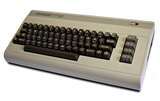As Black Friday and CyberMonday tempt us to buy more technology, I remember the home computer commercials from childhood that helped me convince my parents to buy our first family computer, the Commodore 64.

Selling more than 17 million units in the early 1980’s, the Commodore 64 remains the best selling personal computer of all time.
What did Commodore 64 commercials say that helped me convince my parents to purchase a home computer?
Take a look:
“The SAT Test. It can determine whether a student gets into a good college or not, which is reason enough to own a Commodore computer. Because one recent study shows that preparing for the SAT on a computer can really improve scores.”
How about this one?
“How old should your child be before you buy a computer? High school? When he is planning a career? Elementary school? When she can either fall behind or leap ahead? Or preschool, to give him a head start...”
And my favorite:
“This year, two million families will send their kids off to college. But many of these kids won’t be able to compete because they lack computer skills. A home computer can help... The Commodore 64!”
These early home computer commercials emphasized the value of computers in education.
Being 12 years old, I could remind my parents daily and beg, “See? We need a computer if you want me to get into a good college and have a job in the future.”
It worked. Perhaps the image from the commercial of the kid coming back home after failing college was enough. Or maybe it was the image that I would come back home after high school graduation.
Now computers are everywhere in education. So what else has happened with computers in education during the last 25 years?
Students today integrate computers into every part of their life. They use it for social networking and communication through Facebook, Twitter, and Skype. They complete their homework, do research, get class information from their teacher websites. They chat, shop, listen to music, and watch videos all online. We can do almost everything with a computer.
There is no debate about the benefits of owning a computer. Our debate about purchasing computers today is whether we go PC, Mac, or both. (You Linux users are too geeky for this conversation.)
Our future debates about computers will be on which device we want to use. Smartphone? iPad? Tablet PC? iPod Touch? Galaxy Tab? Netbook? Laptop?
The power of the computers has increased exponentially. To think that one had to plug the Commodore into the living room TV for a display and load programs from floppy disks. These days, my iPhone’s computing power puts the Commodore to shame. (Actually, there is a Commodore iPhone app if I really wanted to go retro.)
Computers and technology changed life dramatically since the days of the Commodore.
But what did not change very much in the last 25 years?
Strangely enough, education was a focus for these early home computer commercials, but education itself has not changed very much in 25 years.
Scantron sheets and Multiple-Choice Tests Get Computerized and Go Online
Seeing the students from the 1980’s in the commercial bubble in scantron sheets reminds me of the students today who do the same thing, but now students take their multiple choice tests online.
Technology has increased our use and dependence on multiple-choice tests. Now we give online multiple choice tests to all students beginning in elementary school several times a year through technologically advanced online common assessments systems so we can disaggregate data through advanced reporting features.
We use this data for instructional planning to make sure all students pass the state standardized tests at the end of the year, which are now also online. For students who receive a passing score, we encourage them to get a higher score on a test with the same multiple-choice test format. For students who do poorly, we remediate so they may pass. How do we assess their progress? Through another online multiple choice test assessment.
Through these online assessment and data systems, we can give multiple choice practice tests for students to take at home, and as often we like, and whenever we like. We even teach strategies to help students become more efficient and savvy with the multiple-choice format.
Teachers can have discussions about how each of their students performed on the multiple choice tests in Professional Learning Communities (PLCs), or, excuse me, Collaborative Teams, and dissect questions for “distractor” words. I remember learning that skill to take the SATs in 1987 and I don’t know if I’ve ever used that skill again.
One would think with the advances in computing technology in the multiple high-tech devices we use on a daily basis, we would integrate more of the features such as multimedia-authoring, communication, networking, and Internet research in our teaching.
We would find better ways to assess student achievement and define what teaching and learning should look like in the 21st Century.
We would hope that our practice could match the power of our technology.
Instead, as we often confine these technologies to be used for multiple choice test formats, whether through classroom response systems and even apps on the iPad or iPod Touch for multiple choice testing.
There are many examples of exciting uses of technology in education to develop innovation and creativity, but not enough of them are going on in schools today. As long as our education policies, official assessments, and definition of school accountability are limited to the multiple-choice format assessment, we will always have some limitations on how we can maximize technology for authentic learning situations that incorporate problem solving, higher level thinking skills, and creativity.
And that’s too bad..... Twenty-five years later, the computers changed, the way students use computers changed, the world has changed.
But many educators are still forced to teach like we still have the Commodore 64.


